Adrian Collins's Blog, page 74
December 4, 2023
REVIEW: Twilight of the Gods by Scott Oden
It is the year 1218, and deep in the wilds of Scandinavia there is a sense that Fimbulvetr, the final winter presaging Ragnarök, is at hand. While the Norse, Danes, and Swedes neighboring them have adopted Christianity, the isolated Raven-Geat tribe reject the so-called “Nailed God” and cling to the old ways. Though surrounded by enemies, the Raven-Geats have a protector known as the Hooded One, immortal herald of the Tangled God Loki. As Twilight of the Gods opens, hot-blooded teenage girl Dísa Dagrúnsdottir has just been chosen by the Fates to serve as the Hooded One’s new priestess. She is shocked to learn that the truculent and mercurial guardian of her people is a literal monster: Grimnir, last of the kaunr, what we would call an orc. As Dísa attempts to survive her new master’s cruel ordeals, a greater threat looms just out of sight. A haunted and deranged zealot fresh from the sack of Constantinople plots a new personal Crusade, one to exterminate the heathen Raven-Geats and unite the Scandinavian peninsula under the White Christ.
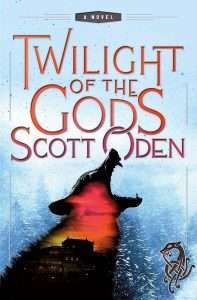 Set two centuries after the events of A Gathering of Ravens, Twilight of the Gods is the second volume in Scott Oden’s GRIMNIR SAGA. Twilight of the Gods manages to be both more intimate and more epic than its predecessor. Where A Gathering of Ravens spans more than a decade, roaming from Denmark to England and then Ireland, Twilight of the Gods mostly confines itself to the wilderness of what is now Sweden. The cast of characters is smaller, but the stakes are much higher. While the first book primarily dealt with a personal vendetta, this time a reluctant Grimnir finds himself called upon both to defend the humans he’s been parasitically lording over for generations and fulfill his role in a prophesized religious war threatening to spark the end of the world.
Set two centuries after the events of A Gathering of Ravens, Twilight of the Gods is the second volume in Scott Oden’s GRIMNIR SAGA. Twilight of the Gods manages to be both more intimate and more epic than its predecessor. Where A Gathering of Ravens spans more than a decade, roaming from Denmark to England and then Ireland, Twilight of the Gods mostly confines itself to the wilderness of what is now Sweden. The cast of characters is smaller, but the stakes are much higher. While the first book primarily dealt with a personal vendetta, this time a reluctant Grimnir finds himself called upon both to defend the humans he’s been parasitically lording over for generations and fulfill his role in a prophesized religious war threatening to spark the end of the world.
Twilight of the Gods is a book drenched in both grim Norse fatalism and blood & thunder heroics. The novels in the Grimnir Saga depict a North where the Old Gods are in decline. Grimnir is the last of his kind, and other once respected and feared supernatural creatures have likewise become relegated to the margins of the world or gone extinct entirely. The influence of Odin and the old pantheon wanes, displaced by the encroaching Christian faith. For Grimnir and many of the other characters in this book, there’s a pervading feeling that the war has already been lost, yet for various reasons they still gear up to fight one last glorious battle. And readers familiar with Oden’s other work, from the previous Grimnir novel to historical adventures like Men of Bronze and The Lion of Cairo, know that Oden can deliver that final battle with gusto. Simultaneously rousing and horrifying, the combats in this novel blend cinematic action with gory, gritty, down-in-the-mud struggle.
As with A Gathering of Ravens, appealing characters are another strong point in Twilight of the Gods. Oden treads a delicate line with his hero Grimnir; he must appear monstrous enough to feel like an “authentic” orc and not just a brutish costumed human, but not so repellent that the reader finds themselves unable to relate to the character or enjoy his exploits. Grimnir is bellicose, capricious, spiteful, and arrogant. He’s casually brutal and an unrepentant murderer. But he’s also an orc of his word, and never fails to repay a debt. In his dealings with humans, who Grimnir views as little more than animals, Oden also imbues him with a mischievous, amused paternalism. Grimnir may not have a heart of gold, but he’s not an outright villain, either. To preserve Grimnir’s mystique, Oden wisely provides primary viewpoint character Dísa as a counterbalance and foil. Imperfect and impetuous, and sharing more than a little of Grimnir’s arrogance, Dísa is an entertaining heroine to follow. Her undying determination is admirable, and it’s interesting to watch her learn when to push back against Grimnir and when to (grudgingly) accept his brusque guidance.
Despite the exceptional quality of the book, Twilight of the Gods had the misfortune of launching in February 2020, roughly simultaneously with the start of the COVID-19 pandemic. With all the societal upheaval, store closures, cancelled events, and supply chain issues that followed, I suspect unlucky timing and curtailed promotions prevented this volume from attracting the audience it deserved. Now is an ideal time to read Twilight of the Gods, however. Its conclusion will leave readers wanting more, just as more is about to arrive: The Doom of Odin, book 3 in THE GRIMNIR SAGA, is scheduled to be released on December 19, 2023.
Wholeheartedly recommended for fans of Vikings, orcs, Viking orcs, tough heroines, Scandinavian metal, and doomed battles against incredible odds.
Read Twilight of the Gods by Scott OdenThe post REVIEW: Twilight of the Gods by Scott Oden appeared first on Grimdark Magazine.
December 3, 2023
REVIEW: Interview with the Vampire Season One 2022
The late Anne Rice’s 1976 Interview with the Vampire is quite rightly a classic of the gothic horror genre. The first instalment in her exceptional The Vampire Chronicles series is one of my favourite reads of all time, and the 1994 film adaptation is also one of my favourite films. So, I have been excited about the TV adaption of Interview with the Vampire for years and eagerly followed all of Rice’s updates on the project. In 2020, AMC acquired and developed the project, and they also have the rights to the remaining novels in The Vampire Chronicles and Rice’s Lives of the Mayfair Witches, so I am braced for a wealth of great things. Both Rice and her son, Christopher, served as executive producers on the project, so although some changes from the novel have been made, they seem to have been done with her knowledge and blessing. The show finally had its UK release this month, and I was so happy to finally watch it.
The eponymous ‘interview’ for this series takes place in Dubai in 2022, with Louis de Pointe du Lac (exceptionally played by Game of Thrones alumnus Jacob Anderson) inviting journalist Daniel Molloy to revisit their earlier interview fifty years on. This series focuses on events from roughly the novel’s first half and is a disappointingly short seven episodes. This time shift explains why certain aspects of Louis’ account from the seventies were left out – namely, in this adaptation of Interview with the Vampire Louis and the hedonistic Lestat de Lioncourt (a mesmerising Sam Reid) are lovers. Lestat’s seduction of Louis and their toxic romantic relationship play a significant part in this version of the story.
There is also a time divergence in terms of setting. AMC’s Louis is a Creole brothel owner whom Lestat turns in the early twentieth century, not the plantation owner turned in the later eighteenth century. I really liked this alteration from the source material. Visually, seeing Louis and Lestat explore the New Orleans of the 1910s was entirely new. Seeing these familiar characters hunting the streets in debonair suits or attending the opera in tuxedos was novel. It also leads to some of the dark comedic moments of the series, like the vampiric trio in hysterical laughter at watching the silent film of Nosferatu in the cinema.
The only change that I personally struggled to get on board with while watching the show was the ageing up of the character of Claudia. In this Interview with the Vampire Claudia (fantastically played by Bailey Bass) was turned by Lestat at fourteen. Bass’ performance is terrific, but the key part of Claudia’s story is that she becomes an adult mentally while being trapped in the body of an immortal child. An eternal teenager faces very different problems from an immortal preteen.
I worked through AMC’s Interview with Vampire over a few days and really enjoyed it. I was literally open-mouthed at the finale and so disappointed to realise I did not have the next episode queued up (having not realised that this series was so darn short!), and I cannot wait to see what this team has done with the adaptation next. I think fans of Rice’s work will like this show, despite some of the departures from her novel, and if you have never come across this world before, but enjoy shows like HBO’s True Blood or NBC’s Hannibal, you would probably also like to sink your teeth in to Interview with the Vampire.
You can watch all of Interview with the Vampire in the UK on BBC iPlayer or purchase it on Amazon Video. The second eight-episode series is currently in production and is predicted to be released in 2024.
The post REVIEW: Interview with the Vampire Season One 2022 appeared first on Grimdark Magazine.
December 2, 2023
REVIEW: Conan the Barbarian #5 by Jim Zub (W) and Doug Braithwaite (A)
Issue 5 of Titan Comics’ Conan the Barbarian begins several months after the conclusion of the “Bound in Black Stone” story arc. Since putting his homeland of Cimmeria behind him, Conan has journeyed across much of the continent and even put to sea as a member of a pirate crew. After loving and losing freebooter queen Bêlit, however, Conan is a drunken shell of a man. He passes his days in disreputable taverns in the even more notorious city of Shadizar, earning his drinking coin acting as a hired thug for an ambitious band of thieves calling themselves the Gloryhounds. Constantly pushing their luck, the aptly named Gloryhounds drag a reluctant Conan into their most audacious heist yet: an attempt to filch Tarim’s Touch—a religious relic carved from dark stone—from the very heart of the Temple of Bel, patron god of thieves.
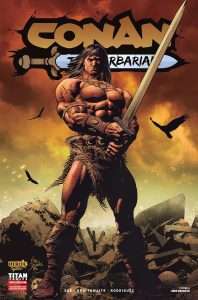 Thus begins the “Thrice Marked for Death” storyline. While Jim Zub continues to handle the writing duties (and is expected to do so for at least the first two years), the change in artwork is instantly noticeable. Scheduled to return with Conan the Barbarian issue 9, Roberto De La Torre is taking a well-deserved break and letting UK artist Doug Braithwaite deliver the artwork for this second arc. Unlike De La Torre’s classic John Buscema-inspired lines, Braithwaite has a thoroughly modern style comparable to the newer Dark Horse and Marvel depictions. Facially, his Conan looks a bit craggier than I would expect for this point in the barbarian’s career (ostensibly still his mid-twenties), but it’s not a bad likeness. The color artist is now Diego Rodriguez, who has given the artwork a sepia cast that suits the torch-lit environs in this issue. While I thoroughly enjoyed De La Torre’s artwork in the previous issues, Braithwaite’s artwork is also appealing and feels appropriate. If this first issue is any indication, it appears that we can expect his combat scenes to be slightly bloodier and more explicit than De La Torre’s. Decapitations may have been ubiquitous in De La Torre’s Conan the Barbarian run, but Braithwaite seems to give Rodriguez many opportunities to reach for the red paint.
Thus begins the “Thrice Marked for Death” storyline. While Jim Zub continues to handle the writing duties (and is expected to do so for at least the first two years), the change in artwork is instantly noticeable. Scheduled to return with Conan the Barbarian issue 9, Roberto De La Torre is taking a well-deserved break and letting UK artist Doug Braithwaite deliver the artwork for this second arc. Unlike De La Torre’s classic John Buscema-inspired lines, Braithwaite has a thoroughly modern style comparable to the newer Dark Horse and Marvel depictions. Facially, his Conan looks a bit craggier than I would expect for this point in the barbarian’s career (ostensibly still his mid-twenties), but it’s not a bad likeness. The color artist is now Diego Rodriguez, who has given the artwork a sepia cast that suits the torch-lit environs in this issue. While I thoroughly enjoyed De La Torre’s artwork in the previous issues, Braithwaite’s artwork is also appealing and feels appropriate. If this first issue is any indication, it appears that we can expect his combat scenes to be slightly bloodier and more explicit than De La Torre’s. Decapitations may have been ubiquitous in De La Torre’s Conan the Barbarian run, but Braithwaite seems to give Rodriguez many opportunities to reach for the red paint.
Conan the Barbarian #5 is set after the events of Robert E. Howard’s 1934 Weird Tales story “Queen of the Black Coast.” It’s briefly touched upon in flashback panels, but readers curious about Conan’s career as a pirate and his tragic, whirlwind romance with Bêlit are encouraged to look there, or perhaps even the 1970s Marvel Comics or 2012 Dark Horse adaptations of the story. For those who are unfamiliar with “Queen of the Black Coast,” Howard scholar Jeffrey Shanks provides some additional background, including spotlighting how it provides rare insight into Conan’s personal philosophy. For my part, I approve of Zub’s choice to deliver new adventures occurring between the original short stories, rather than add to the already tall pile of adaptations. While Conan becomes entangled with a wide variety of women during his later career, I’ve always had the sense that Bêlit was as close as the barbarian ever got to a soulmate, and I’m interested to see if Zub continues to explore Conan’s grief and the aftermath of her death in future issues.
While I was left a little deflated by the finale of the previous plotline, Conan the Barbarian #5 marks a promising start for the second story arc. Braithwaite has a very different visual style than his predecessor, but his gory theatrics a good fit for the series.
Conan the Barbarian #5 by Jim Zub (W) and Doug Braithwaite (A)The post REVIEW: Conan the Barbarian #5 by Jim Zub (W) and Doug Braithwaite (A) appeared first on Grimdark Magazine.
December 1, 2023
REVIEW: Saevus Corax Deals with the Dead by K. J. Parker
Saevus Corax Deals with the Dead is the latest offering from prolific World Fantasy Award winning author K. J. Parker. It is the first in The Corax Trilogy and following Saevus Corax Deals with the Dead there is Saevus Corax Captures the Castle which is out now, and the third instalment Saevus Corax Gets Away with Murder is released in December 2023. So unlike most new releases, if this is the sort of book for you, the whole set will be readily available. If readers have not come across Parker before, they may have read his works that are published as Tom Holt. This was the situation I found myself in where I have enjoyed a fair amount of the books written as Tom Holt but had never picked up a K. J. Parker one until now with Saevus Corax Deals with the Dead.
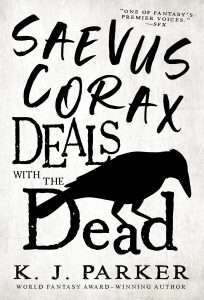 Saevus Corax is in the business of battlefield salvage. He repurposes weapons, fixes holes in uniforms, and deals with the dead. It is not the best or most glamorous of work, but it makes a fair amount of money and someone has to do it. However Saevus Corax was not always Saevus Corax, and something he did a long time ago is about to catch up with him.
Saevus Corax is in the business of battlefield salvage. He repurposes weapons, fixes holes in uniforms, and deals with the dead. It is not the best or most glamorous of work, but it makes a fair amount of money and someone has to do it. However Saevus Corax was not always Saevus Corax, and something he did a long time ago is about to catch up with him.
Although this was my first time reading one of his novels as K. J Parker, Saevus Corax Deals with the Dead has the same dark humour I have enjoyed when reading Tom Holt novels. This novel is cleverly written, and at the end, once the puzzle is complete, the reader can really appreciate how well put together the plot has been. Saevus Corax readily admits he is not a likeable person; by his own admission he is ‘arrogant, callous, selfish and utterly devoid of any redeeming qualities’. This seems slightly unfair as I did not find Saevus to be entirely evil as that description may suggest. He is however eminently practical and (understandably) prioritised his own survival above all other things and this did lead to some rather unsavoury choices. As a protagonist Saevus’ wit and intelligence are highly entertaining and following him through the narrative kept me engaged and invested in Saevus Corax Deals with the Dead. The revelations of Saevus’ somewhat murkier past as he hopped from frying pan to fire and back made me continue with the novel.
Something that is immediately obvious when starting Saevus Corax Deals with the Dead is the Parker has written this in the first person. This was a well written first person novel but I have to admit that settling in to that style took me a very long time. That is very much an issue of mine and my personal preference more than it is a fault of Parkers. At times I also struggled with the pacing of Saevus Corax Deals with the Dead as all the chapters were similarly lengthy. For the more action packed chapters this was not an issue, however in slightly more sedate ones it felt harder to plough through. Parker always brought my attention back, and over all I enjoyed Saevus Corax Deals with the Dead.
Parker’s dry witty style was my favourite part of Saevus Corax Deals with the Dead. It is darkly funny throughout in a way that I think would be enjoyed by readers of Grimdark Magazine. The plot is thoroughly unpredictable and snarky Saevus really made the story for me. Thank you very much to K. J. Parker and the team at Orbit for sending me a copy of Saevus Corax Deals with the Dead.
3.5/5
Read Saevus Corax Deals with the Dead by K. J. ParkerThe post REVIEW: Saevus Corax Deals with the Dead by K. J. Parker appeared first on Grimdark Magazine.
November 30, 2023
An Interview with Patrick Rothfuss – Part 3
We are delighted to release the third and final installment of Grimdark Magazine’s exclusive three-hour interview with Patrick Rothfuss, author of the Kingkiller Chronicle, including the bestselling novels The Name of the Wind and The Wise Man’s Fear. Patrick Rothfuss’s latest entry in the Kingkiller Chronicle, The Narrow Road Between Desires, was released on November 14, 2023.
In this final part of the interview, Beth Tabler and John Mauro talk candidly with Patrick Rothfuss about mental health issues and the double-edged sword of perfectionism. Pat opens up for a raw and emotional discussion about recognizing and overcoming mental health struggles.
In case you missed them, the first part of our interview can be found here and the second part is available here.
Read The Narrow Road Between Desires by Patrick RothfussThe post An Interview with Patrick Rothfuss – Part 3 appeared first on Grimdark Magazine.
November 29, 2023
Fiction open submissions window 2024
It has been a while, authors. AI reared its ugly head causing widespread problems across the fiction industry for publishers, authors, artists, and competition runners, and because of that, we shut our gates for a time. But, the foundation Grimdark Magazine is built upon is the hard work of authors looking for a shot–no matter their fame or publication history–and so Beth and I are throwing caution and work life balance to the wind and running an open fiction window in 2024 to purchase stories for our 2025 issues.
Let’s get stuck in to the details.
The 2024 Grimdark Magazine open windowOn the 1st of March, 2024, at 00:01 AEDT we will be opening up our submissions email address for two weeks until 23:59 14th March, looking for short stories of up to 4,000 words for original fiction, and up to 12,000 words for reprints. Anything submitted over the word limit, or outside of the open window timeframes will be auto-rejected.
We will be looking for grimdark fantasy, as well as the darker grittier side of sci-fantasy and science fiction. We are also after horror in either of those aforementioned settings (eg. with a fantastical or SF aspect that’s key to the story), through a grimdark lens. We encourage diverse authors and those from underrepresented backgrounds to submit stories.
Contemporary settings will be a very hard sell. We do not want pornographic scenes, rape scenes, or tortureporn.
We leave the rest up to you, and no further direction will be provided.
We will expect to purchase between 2-4 original pieces of fiction, and a similar amount of reprints.
What do we define as grimdark?A grim story told in a dark world by a morally grey protagonist.
Submission and timelinesSubmissions will be in Word format via email. Depending on the volume of submissions, we estimate that all acquisition decisions will be made before the end of July 2024, and that that stories will be edited, contracted, paid for, and allocated to a 2025 issue lineup by end of year.
Depending on the volume of stories received, our team may or may not provide feedback on stories.
Statement on AILet’s be absolutely clear about this: we do not want stories created in part or in full by AI tools. We will be using an AI checker, as well as contracting to that effect.
Grimdark Magazine is a people business. Our cover art, editing, fiction, articles, interviews, reviews, videos, branding, design, etc, is all done by people, and we’d like to keep it that way.
It is 100% your choice whether you use AI in writing your fiction. If that’s your process and happy place, then do your thing. Just please don’t send it to us. We don’t want to purchase it or promote it through the platform we’ve spent the better part of a decade building with people who create from the ground up.
Rights and ratesWe will continue to purchase at our current rate of AUD0.07 a word up to the word limit in exchange for exclusive worldwide English rights for one year as of publication, and non-exclusive thereafter. The reprint rate will remain at AUD0.01 a word up to the word limit for non-exclusive rights.
The post Fiction open submissions window 2024 appeared first on Grimdark Magazine.
November 28, 2023
Baldur’s Gate Retrospective
Everyone has a book, movie, or video game that has a special place in their hearts. The actual medium doesn’t matter but the story or characters tantalized you enough that you wanted to experience more. These were our gateway drugs and are things that both tantalize the imagination as well as the spirit. In this case, I’m going to tell you about a game called Baldur’s Gate.
No, not Baldur’s Gate 3, but the original two games as well as the interquel.
Baldur’s Gate wasn’t my introduction to fantasy or even Dungeons and Dragons, but it was something that, nevertheless, kept pulling me back into the world despite the fact it was more or less a “alpha” version of what Bioware would eventually achieve with their far more polished Dragon Age setting. I’m going to discuss the plot of each game in-depth so if you care about spoilers for a twenty-year old game, I recommend you go buy the Enhanced Edition for PC or console then come back in about a hundred hours.
Baldur’s Gate (1998) The premise was you were a convenient orphan who was raised in the library-castle of Candlekeep. You could be a man, woman, elf, human, or whatever that was any number of professions. Freedom was maximized even if your story would probably indicate you would have been learning either how to fight or how to shoot fireballs in version of Faerun’s Library of Congress.
The premise was you were a convenient orphan who was raised in the library-castle of Candlekeep. You could be a man, woman, elf, human, or whatever that was any number of professions. Freedom was maximized even if your story would probably indicate you would have been learning either how to fight or how to shoot fireballs in version of Faerun’s Library of Congress.
Unfortunately, for Gary (as I named my protagonist), he has the problem of being a Chosen One. Not Chosen for anything good like the Dragonborn of Skyrim or Nezzarine. No, he is the child of Bhaal the God of Murder. Bhaal has been dead, a rare status for a god, for decades but his evil essence was passed down to all his mortal descendants.
This is part of a complicated plot to resurrect himself as the surviving Bhaalspawn will kill each other off like immortals in Highlander. The survivors will grow stronger from each person they kill as well as each Bhaalspawn, justifying D&D experience, and eventually the last will become the new God of Murder.
The Highlander influences are actually pretty thick as your opponent is Saverok, your half-brother who is basically the Kurgan. They should have gotten Clancy Brown to do the voice instead of Kevin Michael Richardson (no shade on Trigon and Goro, though). Saverok is smarter than the Kurgan, though, as he’s doing a complicated plot to start a war where he’s supplying both sides with weapons as well as corrupting the iron ore so he has a monopoly on steel. It’s not your typical fantasy villain stuff and while you thwart him, I have to say he’s one of the smarter bad guys in gaming.
Part of what I like about is that it’s only from level 1-10 that you play. Most games go much-much higher. Yet you’re fighting Kobolds, Gnolls, skeletons, and giant centipedes rather than liches as well as other horrors. You can build a party from a couple of dozen NPCs, many of whom don’t get along at all, and while they don’t have much to say–some leave a big impression. For example, I will always love Imoen and refuse to accept she’s my half-sister when my character was fully in love with her.
No Kentucky jokes. Only we can do that.
Baldur’s Gate II: Shadows of Amn (2000)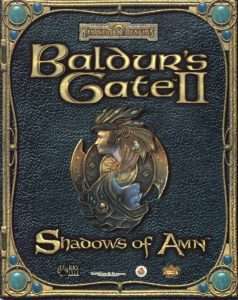 The sequel to Baldur’s Gate is one of those stories that manages to improve on the original with a stronger plot, stronger characterization, darker tone, and motherfricking David Warner. The protagonist has found himself kidnapped by a mad wizard, tortured, experimented on, and stripped of their soul.
The sequel to Baldur’s Gate is one of those stories that manages to improve on the original with a stronger plot, stronger characterization, darker tone, and motherfricking David Warner. The protagonist has found himself kidnapped by a mad wizard, tortured, experimented on, and stripped of their soul.
David Warner’s Jon Irencius is really what makes this module. An exiled elvish archwizard, he is possessed of a complex and interesting backstory that would give a George R.R. Martin protagonist pause. The protagonist isn’t left behind, though, as his relationships with his various associates is allowed to grow considerably. Baldur’s Gate II is where the option to have romances with his or her companions arrived. While some of them were undercooked, especially for female protagonists, others like Viconia have become iconic characters.
If there’s any flaws in the game, it is the fact that the story of the protagonist being the scion of Bhaal takes a backseat to its new villain. This is corrected heavily in the Throne of Bhaal expansion but, briefly, it feels like it is the Irenicus show instead of dealing with the fact you’re the child of an evil god. Which is a rare sentence. The deaths of the beginning of long-time party members Khalid and Dynaheir also added a sense of gravitas that players who didn’t let their party members meet the final death might have missed. Plus, you get to explore the Underdark and that’s always a plus.
It has little to do with Bhaal’s resurrection but is one of the best of Bioware’s stories even today.
Baldur’s Gate II: Throne of Baal (2001)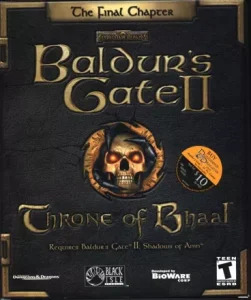 Every journey must come to an end and the Throne of Bhaal is where it reaches its climax. Civilization is under assault by the last of the Bhaalspawn aside from you. The remainder of them have decided to team up in order to make sure there can be only one, sort of like the bad Tributes in The Hunger Games.
Every journey must come to an end and the Throne of Bhaal is where it reaches its climax. Civilization is under assault by the last of the Bhaalspawn aside from you. The remainder of them have decided to team up in order to make sure there can be only one, sort of like the bad Tributes in The Hunger Games.
The Throne of Bhaal brings back the plot of your (un)holy heritage full force and the possibility of resisting becoming a monster or embracing that energy to become a god. It is a genuinely epic quest and one that suffers a bit for the fact that the bosses are somewhat one note compared to Saverok and Irenicus.
The Throne of Bhaal pulls out all the stops and you can effectively slay a god in its final levels or actually do slay a god (or the Lord of the Abyss) with the Demogorgon as a bonus boss. It also has a set of ending slides that manage to incorporate a wide variety of default states depending on your decisions as well as companions.
The only flaw of this installment of the game is that it’s really rather combat heavy over story and the villains are all fairly one-dimensional jerks out for power. There’s a a couple of exceptions and a “twist” villain but none of them match David Warner in terms of performance.
In the end, it is a suitable climax for what was a truly epic adventure until this point.
Baldur’s Gate: Enhanced Edition (2012)The Enhanced Editions would also come out, making all of the games into a single epic adventure with improved graphics as well as game assets. It would also introduce several new companions that would have their own interesting plots and serve as love interests for those not satisfied with Viconia (madness) or Anomen (fair). It would also introduce queer options that weren’t quite as expected in the pre-Bioware era.
Siege of Dragonspear (2016)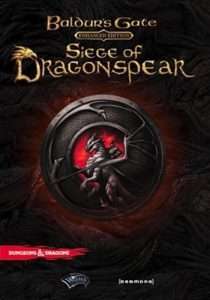 I think it says just about everything you need to know about how Baldur’s Gate touched so many lives that they eventually released an expansion for the first game ten years later. Specifically, eight years after the sequel was done. It’s common enough to do a prequel to games but how often do you have an interquel? That requires a level of fan dedication and love that the developers believe exists to know all the characters as well as their complicated weird plots.
I think it says just about everything you need to know about how Baldur’s Gate touched so many lives that they eventually released an expansion for the first game ten years later. Specifically, eight years after the sequel was done. It’s common enough to do a prequel to games but how often do you have an interquel? That requires a level of fan dedication and love that the developers believe exists to know all the characters as well as their complicated weird plots.
The Siege of Dragonspear is designed to bridge the gap between Baldur’s Gate and Baldur’s Gate 2: Shadow of Amn where the protagonist goes from being on top of the world to a hated outcast despite saving the world (or at least Sword Coast) from Saverok. You do, indeed, start off as living in the Ducal Palace of Baldur’s Gate, beloved by all (though my in-game reputation was absolute crap due to killing a few hundred guards), and spending time with his beloved sister Imoen.
Unfortunately, the reward for a job well done is to do it all over again and Gary is called upon to slay the Joan of Arc-like figure leading a crusade across the Sword Coast. No one is entirely sure WHY the woman is leading a crusade, but her followers are looting and pillaging in the name of all the gods. Which, given this is the Forgotten Realms, is ridiculous. The gods hate each other. So, you have to get the band back together in order to lead an army to slay her and disperse her rebellious forces.
With ten years of game technology advances, the game looks visually spectacular while remaining an isometric top-down RPG. The dialogue also gets to take advantage of the fact that we know where all the characters will end up. The game is heavy on foreshadowing and contains one of the last performances by the amazing David Warner (AKA Batman: The Animated series’ Ra’s Al Ghul and Jon Irenicus). The protagonist’s dialogue options also get a lot “sillier” options, which implies the events of the first game have driven them to become a snarky bastard.
A sense of doom hangs over the expansion and the funny thing is that it makes the story much-much better, which shouldn’t be possible for two such classic games. The fusion isn’t always one hundred percent perfect but it’s close enough. In the end, no matter what you do, someone good is going to get hurt as well as the line between good and evil being blurred.
ConclusionThe Baldur’s Gate franchise would continue with some novelizations (that were absolutely awful—no offense to the author), comic books (which I adore), as well as its sequel Baldur’s Gate III.
The post Baldur’s Gate Retrospective appeared first on Grimdark Magazine.
REVIEW: Conan: Lord of the Mount by Stephen Graham Jones
Lord of the Mount opens with Conan as the last survivor of a vanquished raiding party. Surrounded by the dead, as the battered barbarian’s consciousness returns the first shapes that come into view are that of a small group of cattle and their herder. The eyes of both the cows and the man tending them have a strange purple tinge to them, hinting at long term use of the intoxicating powder of the black lotus. Wary of the shifty lotus addict, Conan nevertheless accepts a meal of wine and steak—carved directly from the flanks of the passive, drugged cattle—from the man. Known as Jen Ro, the herdsman tells Conan of his destination: the village of Trinnecerl, where ale and women are plentiful. He warns that the mountain pass leading to the village is guarded by a fearsome monster, however, the so-called Lord of the Mount. With no better destination in mind, the rootless barbarian wanderer elects to accompany Jen Ro, hoping to indulge himself in the pleasures Trinnecerl has to offer and see this Lord of the Mount for himself. Conan soon finds himself fighting for his life against a foe unlike any he has faced before.
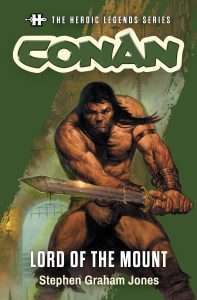 Lord of the Mount is the first installment in the Heroic Legends series of monthly digital short stories starring Conan the Barbarian and other pulp fiction heroes created by Robert E. Howard. While not the first piece of new Conan fiction produced via the partnership between Titan Books and Howard franchise owner Heroic Signatures (that would be the Conan – Blood of the Serpent novel by S. M. Stirling), news of the Heroic Legends series was welcomed by Conan and Howard fans for a number of reasons. One was that the Conan stories and the sword & sorcery subgenre of fantasy as a whole originated as short stories and still tend to be most at home in that format. Another reason was the roster of authors listed with the series announcement. Experienced and reliable Conan authors such as John C. Hocking and Scott Oden were present and accounted for, yes, but there were also unexpected curve-balls like Laird Barron and V. Castro. Of the latter group, Stephen Graham Jones was a particularly anticipated contributor, as not only is his star currently ascendant within the horror genre (a field with considerable overlap with sword & sorcery), but his 2021 autobiographical Texas Monthly essay My Life With Conan the Barbarian had already fostered a sense of kinship among many sword & sorcery fans. Jones gets it, he’s one of us. We wanted to see what he could do with the character.
Lord of the Mount is the first installment in the Heroic Legends series of monthly digital short stories starring Conan the Barbarian and other pulp fiction heroes created by Robert E. Howard. While not the first piece of new Conan fiction produced via the partnership between Titan Books and Howard franchise owner Heroic Signatures (that would be the Conan – Blood of the Serpent novel by S. M. Stirling), news of the Heroic Legends series was welcomed by Conan and Howard fans for a number of reasons. One was that the Conan stories and the sword & sorcery subgenre of fantasy as a whole originated as short stories and still tend to be most at home in that format. Another reason was the roster of authors listed with the series announcement. Experienced and reliable Conan authors such as John C. Hocking and Scott Oden were present and accounted for, yes, but there were also unexpected curve-balls like Laird Barron and V. Castro. Of the latter group, Stephen Graham Jones was a particularly anticipated contributor, as not only is his star currently ascendant within the horror genre (a field with considerable overlap with sword & sorcery), but his 2021 autobiographical Texas Monthly essay My Life With Conan the Barbarian had already fostered a sense of kinship among many sword & sorcery fans. Jones gets it, he’s one of us. We wanted to see what he could do with the character.
The strong points of Lord of the Mount are its minimalist premise and brisk pace. No time is wasted getting to the good stuff. The scene is set, Conan hits the road, and a knock-down, drag-out battle with the Lord of the Mount follows.
Unfortunately, Lord of the Mount is not entirely successful. Unlike many Conan pastiche writers, Jones made little effort to emulate Howard’s writing style. But he also didn’t seem to write in the colloquial, almost folksy voice Jones used in other works like The Only Good Indians. The result is sort of a hybrid, neither fish nor foul. Dissimilar to Howard, but also not quite Jones’ natural narrative voice.
The portrayal of Conan also felt off in parts. During his battle with the Lord of the Mount, in multiple instances Conan is described as “screaming.” Conan has never struck me as much of a screamer, but even if he had occasion to scream at least some of these screams should have been changed to “bellows” or “roars” for variety’s sake. Also, when Conan reunites with Jen Ro in the story’s denouement he reacts as if he has been subjected to a betrayal worthy of violent retribution. However, at the beginning of the story Jen Ro is pretty forthright when describing the danger of the Lord of the Mount and the means he uses to evade it, making Conan’s rage feel excessive and unwarranted.
While I expected more from a Stephen Graham Jones take on Conan, Lord of the Mount is still worth the small price of admission. I appreciate Titan Books’ willingness to go beyond safe and expected Conan writers, giving readers a chance to see a variety of different interpretations and portrayals of a familiar character.
Conan: Lord of the Mount by Stephen Graham JonesIn the US? You can get the book here.
The post REVIEW: Conan: Lord of the Mount by Stephen Graham Jones appeared first on Grimdark Magazine.
November 26, 2023
REVIEW: The Year’s Best Dark Fantasy and Horror (Volume 4) edited by Paula Guran
I love that time of year when Paula Guran releases her newest volume of The Year’s Best Dark Fantasy and Horror. This year’s anthology, officially titled The Year’s Best Dark Fantasy and Horror (Volume 4), is actually Guran’s fourteenth entry in the series, having restarted the numbering after switching to a new publisher (Pyr Books) four years ago.
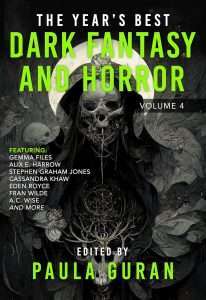 Across her prolific career, Paula Guran has published over fifty anthologies in fantasy, science fiction, and horror. She is a two-time winner of the Bram Stoker Award and two-time nominee of the World Fantasy Award. With Paula Guran as editor, you know it will be a top-quality collection.
Across her prolific career, Paula Guran has published over fifty anthologies in fantasy, science fiction, and horror. She is a two-time winner of the Bram Stoker Award and two-time nominee of the World Fantasy Award. With Paula Guran as editor, you know it will be a top-quality collection.
The Year’s Best Dark Fantasy and Horror (Volume 4) kicks off with “Shadow Plane,” Fran Wilde’s story of the physical and psychological isolation of two travelers stranded on a mountain that doesn’t appear on any map. The story is masterfully written and reads like an alpine version of The Blair Witch Project.
The next story, “The Dyer and the Dressmakers” by Bindia Persaud, is a subtle but unsettling tale, full of enchanting colors, where dying and dyeing are more than just homophones.
It seems inevitable that at least one of the stories in The Year’s Best Dark Fantasy and Horror would be a repeat from another collection that I’ve read. That story for me is the wickedly horrific “Wet Red Grin” by Gemma Files, which I also reviewed as part of Ellen Datlow’s outstanding anthology, Screams from the Dark. Personally, I enjoyed revisiting this masterful story set in a nursing home during the real-life horror of the COVID-19 pandemic.
Next up is “The Lending Library of Final Lines,” a dark fantasy by Octavia Cade about a magical book that can pull readers into the story when the pages are eaten. The setup of this story reminded me of The Book Eaters by Sunyi Dean.
Stephen Graham Jones is always a delight, and “Men, Women and Chainsaws” doesn’t disappoint. His contribution to The Year’s Best Dark Fantasy and Horror (Volume 4) has a classic horror feel and is inspired by the ultraviolent The Texas Chainsaw Massacre 2.
The shortest story in The Year’s Best Dark Fantasy and Horror (Volume 4), “The Woman Who Married the Minotaur” by Angela Slatter, is brief but fun. The story is exactly what you would think based on the title.
Probably my favorite story in the collection is “The Voice of a Thousand Years” by Fawaz Al Matrouk. This story is both a philosophical tour de force and a deeply emotional tale of an old man who discovers spiritual transference.
I also thoroughly enjoyed “Bonesoup” by Eugenia Triantafyllou, about a grandmother who wants to provide proper nourishment to strengthen her granddaughter’s bones. “Bonesoup” has a fairy tale-type quality that strikes the perfect balance between dark fantasy and horror.
Cassandra Khaw’s contribution to the anthology, “How Selkies Are Made,” feels like a companion story to their masterful dark fantasy novella, The Salt Grows Heavy. The short story is not as dark as the novella, but it’s still an enjoyable read.
I adore just about all horror stories from A.C. Wise. Her contribution to The Year’s Best Dark Fantasy and Horror (Volume 4), “Sharp Things, Killing Things,” is a stylistic departure for Wise, told in the first-person plural. Wise succeeds in capturing the collective zeitgeist of young people in small-town America while delivering a truly chilling tale of horror.
A few of the stories were more uneven in the middle of The Year’s Best Dark Fantasy and Horror (Volume 4), but the anthology closes out strong with the final two stories: “A Monster in the Shape of a Boy” by Hannah Yang and “Lemmings” by Kirstyn McDermott, both of which are very creative and well written. Part of the joy of reading short story anthologies is discovering new writers. Both Hannah Yang and Kirstyn McDermott are new to me, and I look forward to reading more from them in the future.
Whether your goal is to discover new authors or revisit established favorites, The Year’s Best Dark Fantasy and Horror (Volume 4) is a very welcome addition to Paula Guran’s long-running series.
4/5
Read The Year’s Best Dark Fantasy and Horror (Volume 4) edited by Paula GuranThe post REVIEW: The Year’s Best Dark Fantasy and Horror (Volume 4) edited by Paula Guran appeared first on Grimdark Magazine.
November 25, 2023
REVIEW: Curious Tides by Pascale Lacelle
If you’re like me and love books (almost) as much as physical objects than you do as stories, Curious Tides by Pascale Lacelle should be on your to-buy list. A dark academia story about class, arrogance and magic waits for you within the pages. On the outside, it is one of the prettiest books on the market. Its astrological themes influence the design, and decorations adorn the pages, drawing you deeper into the story. In that regard, it’s picking up much of what makes dark academia stand out, and combining it with a celestial aesthetic that is a trend in its own right.
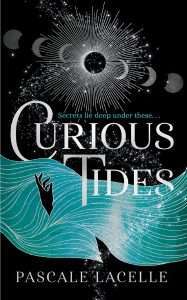 At Aldryn College of Lunar Magics, students are divided into houses based on the phases of the moon – and then, there are the Eclipse-born, powerful but often outcast. Emery is a healer, member of house New Moon at Aldryn. Or at least, that’s what her mother told her father before disappearing. She’s reserved and often feels inadequate in the company of her wealthy peers. She’s always relied on her friend Romie to be her social catalyst, to make sure she’s included. But Romie’s dead, along with seven of Aldryn’s best and brightest. Emery is convinced she can find out what really happened – no matter what it costs her. Soon she’s embroiled in secret societies, deception and powerful but forbidden magic.
At Aldryn College of Lunar Magics, students are divided into houses based on the phases of the moon – and then, there are the Eclipse-born, powerful but often outcast. Emery is a healer, member of house New Moon at Aldryn. Or at least, that’s what her mother told her father before disappearing. She’s reserved and often feels inadequate in the company of her wealthy peers. She’s always relied on her friend Romie to be her social catalyst, to make sure she’s included. But Romie’s dead, along with seven of Aldryn’s best and brightest. Emery is convinced she can find out what really happened – no matter what it costs her. Soon she’s embroiled in secret societies, deception and powerful but forbidden magic.
Curious Tides has many strengths. Characters come alive and none of them can truly be perceived as good. Lies, whether from good intentions or malicious ones, dominate the story. It was refreshing to see Emery be nothing special. This evolves over the course of the story, of course – she does have to go from “ordinary girl” to “main character” after all. But she starts out struggling, is often called out when she misses the mark. Because she’s always been next to someone people consider special, she never considered whether she may not be quite as mediocre as she’s believed. I loved seeing her evolution, gaining confidence and power. Obsessed with her mission, Emery lies and cheats, considering her aims more important than the rules – and perhaps even other people. But, she’s not the only interesting character. I loved bookish Baz especially, dealing with a complicated past and trauma. Romance is not central to the story, as Curious Tides puts the focus on character development for their own sakes.
I did feel like the magic system could have been more developed. It is more vibes than facts, loosely inspired by the phases of the moon. And it does work – as long as you don’t question it. It compliments the story and at times works as a bit of a deus ex machina. The reader, however, who pays attention will soon notice that it doesn’t continue past the basics needed to tell this particular story. Question don’t lead to answers, and I felt that I did not get a sense of how magic influences the society at large, how it functions on a more theoretical level.
As a whole, Curious Tides was a lovely and captivating read. An ambitious debut, promising much more to come. I look forward to reading more in this world, and would especially recommend Curious Tides to fans of A Study in Drowning.
Read Curious Tides by Pascale LacelleThe post REVIEW: Curious Tides by Pascale Lacelle appeared first on Grimdark Magazine.



